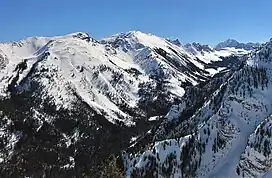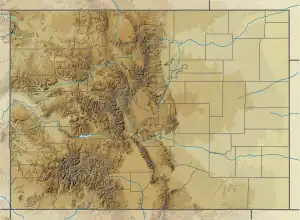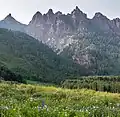| Sievers Mountain | |
|---|---|
 North aspect in winter | |
| Highest point | |
| Elevation | 12,786 ft (3,897 m)[1] |
| Prominence | 751 ft (229 m)[1] |
| Parent peak | Maroon Bells[1][2] |
| Isolation | 1.64 mi (2.64 km)[1] |
| Coordinates | 39°06′56″N 106°56′42″W / 39.1156323°N 106.9449042°W[3] |
| Geography | |
 Sievers Mountain Location in Colorado  Sievers Mountain Sievers Mountain (the United States) | |
| Country | United States |
| State | Colorado |
| County | Pitkin |
| Protected area | Maroon Bells–Snowmass Wilderness |
| Parent range | Rocky Mountains Elk Mountains[4] |
| Topo map | USGS Maroon Bells |
| Geology | |
| Age of rock | Permian |
| Type of rock | Maroon Formation[5] |
| Climbing | |
| Easiest route | class 3 scrambling[1] |
Sievers Mountain is a 12,786-foot (3,897 m) summit in Pitkin County, Colorado, United States.
Description
Sievers Mountain is located 21 miles (34 km) west of the Continental Divide in the Elk Mountains which are a subrange of the Rocky Mountains. The mountain is situated seven miles (11 km) southwest of the community of Aspen in the Maroon Bells–Snowmass Wilderness, on land managed by White River National Forest.[4] Precipitation runoff from the mountain's slopes drains into Willow and Maroon creeks which are tributaries of the Roaring Fork River. Topographic relief is significant as the summit rises 4,000 feet (1,219 m) above Maroon Creek in 1.5 mile (2.4 km) and 1,950 feet (594 m) above Willow Creek in 0.75 mile (1.21 km). The Maroon Bells viewed from Maroon Lake is the most-photographed place in Colorado.[6] The lake was formed when a landslide from the slopes of Sievers Mountain slid into the valley and dammed West Maroon Creek.[7] The mountain's toponym has been officially adopted by the United States Board on Geographic Names.[3]
Climate
According to the Köppen climate classification system, Sievers Mountain is located in an alpine subarctic climate zone with cold, snowy winters, and cool to warm summers.[8] Due to its altitude, it receives precipitation all year, as snow in winter and as thunderstorms in summer, with a dry period in late spring. Climbers can expect afternoon rain, hail, and lightning from the seasonal monsoon in late July and August.
Gallery
See also
 Mountains portal
Mountains portal- Mountains of Pitkin County, Colorado
References
- 1 2 3 4 5 "Sievers Mountain - 12,786' CO". listsofjohn.com. Retrieved June 14, 2023.
- ↑ "Sievers Mountain, Peakvisor.com". Retrieved June 14, 2023.
- 1 2 "Sievers Mountain". Geographic Names Information System. United States Geological Survey, United States Department of the Interior. Retrieved June 14, 2023.
- 1 2 "Sievers Mountain, Colorado". Peakbagger.com. Retrieved June 14, 2023.
- ↑ Bruce Bryant, Geologic map of the Maroon Bells quadrangle, Pitkin and Gunnison Counties, Colorado, U.S. Geological Survey, 1969.
- ↑ Susan Joy Paul, Stewart M. Green (2022), Best Lake Hikes Colorado, Rowman & Littlefield, ISBN 9781493046836, p. 56.
- ↑ Marty Bartholomew (2010), Great Places: Colorado, Wilderness Adventures Press, ISBN 9781932098686, p. 182.
- ↑ Peel, M. C.; Finlayson, B. L.; McMahon, T. A. (2007). "Updated world map of the Köppen−Geiger climate classification". Hydrol. Earth Syst. Sci. 11. ISSN 1027-5606.
External links
- Sievers Mountain: weather forecast



